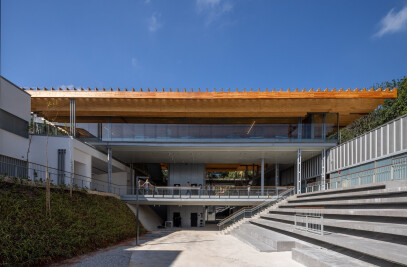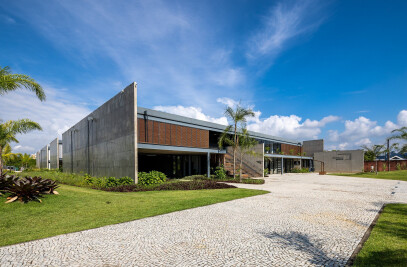The challenge was design an ephemeral pavilion with large experimental freedom, without the usual constraints that are present in conventional briefings. It proposed an initial implementation at CASACOR Minas that could allow varied uses and, at the same time, could be dismantled and reassembled in other contexts.
Its insertion at Sapucaí Street, a complex and lively urban context that is going through a recent transformation: the elevated terrace offers a great view to the city; the existing old locomotive is integrated to the building; the shade of the trees; the listed building's facade define a strong materiality against the quite immaterial presence of the pavilion.
The pavilion uses welded rebar screens in regular fabrication sizes to define the whole modulation of the system, in order to avoid waste and production losses. It adopts an industrialization of the parts that are assembled on site, in order to allow its disassembly at the end of the event, its transportation to a definitive location and its integral reassembly, where it can fit to other uses. With this strategy, we increase the lifespan of this small building.
That is, thus, more than a building or an object, it results from a systemic logic: modules of supporting walls, modules for ceilings, modules for service spaces and toilets, leveling support pieces, modules for grades and benches. The idea of a system will allow to think on other pavilions and buildings, larger, smaller, with different spacial configurations and for other functions.
Its assembly logic demands walls at least in two of the four sides, or partial walls in the four sides. The ceiling modules, that measure 6 x 6 meters, can be articulated in line, in grid or in alternated grid. Thus, a group of possibilities plenty of variations and scales derives from the alternatives, revealing a great multi purpose potential of the system, that can be served by service spaces according to specific needs, in a combination of determined functional modules with large undetermined flexible spaces. In the service modules, the interior closed spaces have an exterior mirror finishing, reflecting the rebar screen that surrounds it, thus dissimulating the presence of the enclosed areas and reinforcing the diaphanous and immaterial character of the construction.
The possibility of dismissing heavy envelopes and strict definitions between interior and exterior favor the integration with the surroundings, with great transparency and permeability. To the assembly at CASACOR Minas, we included light linen curtains that amplify the intimacy of the interior space and, when open, allow a full integration with exterior spaces and the crossing of views through the structural screens. For the moments when the pavilion is open to free use, rebar hooks support hammocks, creating a ludic space that offers to public an interval in the intense experience of the event. The steel cloud at the same time houses and subtly reveals the interior space. So is this pavilion that we carefully conceived, that offers to the visitors a place for a break in the intensity of everyday life.
Material Used :
1. Construction Steel
2. Glass
3. MDF

































